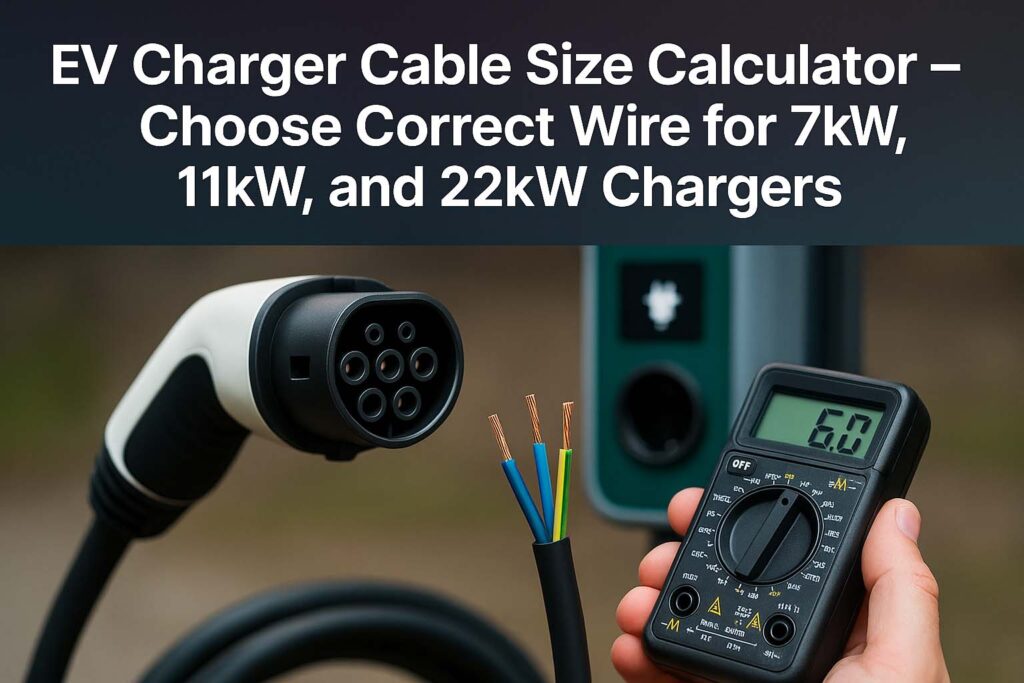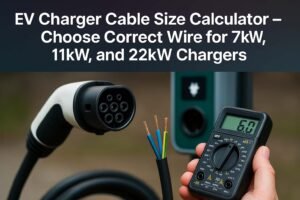EV Charger Cable Size Calculator: Best Tool
Choosing the right EV charger wire size is not just about following a chart. It directly impacts the safety, efficiency, and cost-effectiveness of your EV charging setup. Whether you’re installing a home EV charger or a commercial setup, the cable must handle the required load without overheating or voltage drop.
Table of Contents

Understanding 7kW cable size, 11kW, and 22kW charger requirements ensures your system runs reliably and complies with regulations. Oversized cables add cost; undersized ones are a safety hazard. This guide simplifies your decision with technical insights, practical advice, and accurate calculations.
As electric vehicles continue to grow in popularity across Europe, especially in the UK and Germany, homeowners and installers are asking the same question: what cable size do I need for my EV charger installation? Let’s break it down based on charger size, installation environment, and cable length.
Key Takeaways:
- Always size cables based on the charger’s power rating, cable length, installation method, and allowable voltage drop
- For a 7kW EV charger, 6mm² cable is typically sufficient up to 20 meters, but longer runs may require 10mm²
- An 11kW EV charger usually needs 10mm² or more, especially if the run exceeds 25 meters
- 22kW chargers, which are three-phase, demand at least 6mm² or 10mm² depending on distance and installation method
- Use an EV charger cable size calculator to ensure compliance with local electrical standards and safety margins
Understanding EV Charger Wire Size
Every EV charger draws current based on its rated power. For instance, a 7kW charger typically draws about 30A on a single phase. As the current increases, so does the size of the wire needed to handle that load safely. The cable must not overheat and must maintain a voltage drop within acceptable limits (usually ≤5%).
Wire size is also influenced by whether the charger is single-phase or three-phase. A single-phase 7kW charger will draw more current per phase than a three-phase 22kW charger, where the current is distributed across three wires.
The most common materials used in EV charger wiring are copper (Cu) and aluminium (Al). Copper has higher conductivity and is more commonly used for home and commercial EV chargers.
When calculating wire size, factors to consider:
- Charger power (kW)
- Voltage (230V for single-phase, 400V for three-phase)
- Cable length
- Type of installation (buried, surface mounted, in conduit)
- Ambient temperature
- Permissible voltage drop
- Correction factors (e.g. for grouping or insulation type)
EV Charger Cable Size Calculator
Use our online tool House Wiring Cable Size Calculator – Safe and Efficient Sizing for Home Circuits
Cable Size for 7kW EV Charger
A 7kW charger typically operates on a single-phase 230V connection. The current drawn can be calculated as:
Current (I) = Power (P) / Voltage (V)
I = 7000W / 230V ≈ 30.4A
So, the wire must safely carry at least 31A. In most residential setups, 6mm² copper cable is sufficient for runs up to 20 meters. Beyond that, voltage drop becomes a concern, especially if the charger is installed in a detached garage or far from the main consumer unit.
Recommended Cable Size for 7kW EV Charger:
| Cable Length (meters) | Recommended Cable Size (Copper) | Voltage Drop (%) |
|---|---|---|
| 5 – 10 meters | 6mm² | <2% |
| 10 – 25 meters | 6mm² | 2–4% |
| 25 – 40 meters | 10mm² | <5% |
If using aluminium cable, increase the size by at least 50% due to lower conductivity.
Use our online tool Short Circuit Current Calculator for Motors – Accurate Fault Current Calculation Guide
Cable for 11kW EV Charger Installation
An 11kW charger usually runs on a three-phase 400V connection, drawing around 16A per phase:
I = 11000W / (√3 × 400V) ≈ 15.9A
Because the current is lower per conductor, 6mm² cable can be used for shorter runs. However, considering installation conditions, a 10mm² cable is often used to future-proof the setup and reduce voltage drop.
Recommended Cable Size for 11kW EV Charger:
| Cable Length (meters) | Recommended Cable Size (Copper) | Voltage Drop (%) |
|---|---|---|
| 5 – 15 meters | 6mm² | <2% |
| 15 – 30 meters | 10mm² | 2–4% |
| 30 – 50 meters | 16mm² | <5% |
Using XLPE-insulated SWA (steel wire armoured) cable is advisable for outdoor or underground runs. Ensure your cable is rated for 600/1000V.
Use our online tool Short Circuit Current Calculator for Transformers: Best Tool
Wire Size for 22kW EV Charger
A 22kW charger is three-phase and draws approximately 32A per phase:
I = 22000W / (√3 × 400V) ≈ 31.8A
This is double the current of an 11kW charger, and voltage drop becomes more significant at long distances. Use 10mm² or 16mm² copper cable, depending on distance and installation method.
Recommended Cable Size for 22kW EV Charger:
| Cable Length (meters) | Recommended Cable Size (Copper) | Voltage Drop (%) |
|---|---|---|
| 5 – 10 meters | 10mm² | <2% |
| 10 – 25 meters | 16mm² | <4% |
| 25 – 40 meters | 25mm² | <5% |
A properly designed cable for EV charger installation ensures not only efficiency but long-term safety. Always consult local wiring regulations such as BS 7671 (UK Wiring Regulations) or IEC 60364 (European Standard).
Using an EV Charger Cable Size Calculator
Manual calculation of cable size can be complex. That’s why most installers and engineers now rely on an EV charger cable size calculator. These calculators take into account:
- Phase type (single or three-phase)
- Distance of run
- Load in kW or Amps
- Voltage
- Permissible voltage drop
- Cable type and insulation
- Installation method
Use our online tool Short Circuit Current Calculator – Accurate Short Circuit Calculation for Safe Electrical Design
These tools help prevent under-sizing and ensure compliance with national codes. Most calculators also provide wire sizes in both mm² and AWG for international use.
If you’re installing at home, ensure the consumer unit has capacity for the additional current. A dedicated MCB (miniature circuit breaker) or RCBO (residual current circuit breaker with overcurrent protection) is recommended. For 7kW or higher installations, a Type A or B RCD is essential due to DC leakage current risk from EVs.
Common Mistakes When Choosing EV Charger Wire Size
Many homeowners and even some electricians make mistakes when choosing the cable for EV charger installation. Here are a few to avoid:
Ignoring voltage drop – even if the cable can handle the current, long runs can cause significant voltage drop that affects charger efficiency.
Not factoring in cable routing – cables running in insulation or buried underground require de-rating and larger sizes.
Skipping future-proofing – it’s more cost-effective to install 10mm² now than upgrade from 6mm² later when you move to 11kW or 22kW charging.
Using unsuitable cable types – avoid T&E (twin and earth) for outdoor runs; use SWA or HO7RN-F.
Not using a calculator – assumptions can lead to undersized or oversized cables. Use a reliable calculator or consult a qualified electrician.
Use our online tool Wire Size Calculator for Subpanels and Feeders – NEC Guidelines Included
Conclusion
The growth of electric vehicles demands smarter infrastructure, and selecting the right EV charger wire size is a critical part of that. Whether you’re installing a 7kW charger in your garage or a 22kW three-phase charger at a workplace, proper cable sizing ensures safety, performance, and regulatory compliance.
Rely on accurate current calculations, consider installation conditions, and when in doubt, always consult with a certified electrician. A well-sized cable not only protects your investment but also supports faster, safer EV adoption.
Follow Us on Social:
Subscribe our Newsletter on Electrical Insights to get the latest updates in Electrical Engineering.
#EVChargerCableSize, #CableSizeCalculator, #EVWiringGuide, #7kWCableSize, #11kWCableSize, #22kWCableSize, #EVChargerInstallation, #ElectricVehicleCharging, #EVChargerWireSize, #HomeEVCharger, #EVCableStandards, #EVChargerSetup, #EVInfrastructure, #WireSizing, #ElectricalSafety
EV Charger Cable Size Calculator: Best Tool : Electrical Engineering Hub

Calculate the perfect cable size for your EV charger with our EV Charger Cable Size Calculator. Get accurate wire sizing for safe and efficient EV charging at home or commercial stations. Ideal for electricians, EV owners, and installers.
Price Currency: USD
Operating System: All
Application Category: WebApplication

I every time emailed this webpage post page to
all my associates, since if like to read it afterward my friends will too.